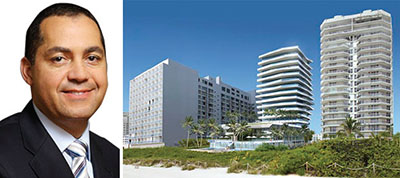Trending
Peebles heads south

As summer turns to fall and New Yorkers adjust to cooler temperatures, developer Don Peebles, like a snowbird, is heading south to Coral Gables.
After a few months working from the Hamptons and Madison Avenue, Peebles is now turning his attention to the Peebles Corp.’s developments in South Florida. His priorities right now are the 13-unit Miami Beach condominium project, Bath Club Estates, and the redevelopment of the low-income Overtown neighborhood west of downtown Miami. The Overtown project includes a 150-room hotel, offices, retail and 350 rental apartments.
Bath Club Estates is smaller than the earlier Peebles-developed Residences at the Bath Club, but no less luxurious. A 9,200 square foot triplex penthouse there, which features an additional 9,000 square feet of outdoor space, hit the market in August for $50 million.
Peebles, CEO of one of the nation’s biggest African-American-owned development firms, talked with The Real Deal about Miami banks’ reluctance to lend, the potential rise of North Miami and grooming his children for power positions in the company.
How did you determine there was demand for large units at Bath Club Estates?
The average unit size at Bath Club Estates is almost 6,000 square feet. That’s practically unheard of in Miami. [Units at the Residences at the Bath Club averaged 3,600 square feet.] We see Miami with the perspective of what’s taking place in New York, like in Tribeca at 108 Leonard Street. Working on developments in Washington, D.C., and New York, which are critical markets, we saw that [large] units sell for huge premiums on a per-square-foot basis. At 15 Central Park West in 2011, a triplex penthouse sold for a record $13,000 per square foot. One57 units are also getting a high price per square foot. I thought it made a lot of sense for that to happen in Miami. The buyer is increasingly sophisticated and demands a higher level of luxury.
What are the pros and cons of developing in South Florida versus New York?
In New York, there’s constant construction activity. Construction and design professionals continue to work on large-scale projects and continue to be available, so you have a high level of efficiency and professionalism. In Miami, in 2008, the clock just stopped. Buildings in development came to a screeching halt. People in Miami didn’t have jobs. They left the market and went someplace else — or they chose another profession. When the market picked up again, it’s hard to find enough people to execute a project. You don’t have an institutional level of professionalism and quality, and that’s a challenge.
How about financing projects in Miami?
[One] challenge is raising capital for development. Local Miami banks are the most reluctant places, in that they’re the last to make loans in their own marketplace. Global banks and private equity funds are a lot quicker to jump at that opportunity. By the time the local banks get into the marketplace, they take on second- and third-tier loans.
What is the status of the Overtown project?
We’ve signed our deal for a second site there. The two projects combined are well over 1.5 million square feet. They will be a significant economic engine, to the tune of about $600 million. There are significant job and economic opportunities for the community that really had been destroyed in Overtown. It lost its spirit, identity and character.
Are you looking at Miami waterfront opportunities?
We’re looking at a few things right now that are on the water in Downtown Miami. We also want to buy more in North Miami, because there is growing demand from young professionals who work in Miami and don’t want to live in the suburbs. They want to be close to Downtown or the beach. If Miami Beach continues to price people out of the market, we need a vantage point north in Miami-Dade County. We’re considering condos and luxury rentals. We are looking to grow our portfolio on the residential rental side, and in the commercial office market.
You also have a development in the Florida Keys. What’s happening with that?
We’ve owned that site for a number of years and right now we’re looking to move that project [featuring 72 waterfront homes] forward and make it more contemporary in terms of amenities and technology — to make it more consistent with today’s market. When we conceived of it back in 2007, our goal was to be the most cutting-edge in terms of luxury design in that market.
What else are you busy with in other cities?
We have a $4 billion development pipeline right now, including a Kimpton Hotel in Philadelphia that is replacing the Family Court building. We see that as a significant growth market, in addition to New York and Miami. We expect in the next year to add $1 billion to our pipeline.
Five years from now, do you see yourself continuing to juggle all these projects year-round?
I have told, jokingly, the senior team of our company — as well as my son, a 20-year-old junior at Columbia University — that I’ve got seven more years of traveling. At that point, my daughter will have graduated high school and … my son will have been a veteran of the company for almost 10 years. He’s worked for us every summer since he graduated high school. He’s the lead person on a deal right now involving a Standard Hotel in Washington, D.C. In seven years, I see myself being more of an elder statesman of the company. This is the last market cycle where I’m going to be the guy on the front lines, still working deals and jumping all around the country.




